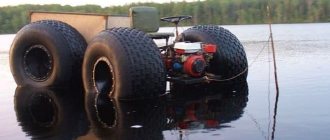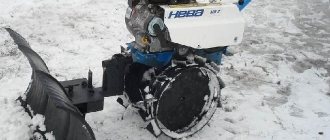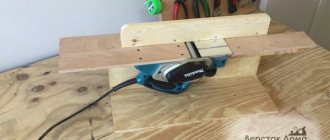At present, the development of agricultural machinery has reached a high level of development. It is difficult to imagine a modern farmer without a cultivator or walk-behind tractor.
There are many varieties of walk-behind tractors on sale, but most store-bought ones are designed for small areas - up to 6 acres. There are more powerful industrial-type units, but their price will be much higher. Considering that the structure of walk-behind tractors is not so complicated, you can make a walk-behind tractor with your own hands.
A snowmobile made from a motorcycle? Really!
Snowmobiles are an extremely useful tool for winter hunting and fishing, even without taking into account the fact that in some regions movement is possible only on such vehicles. Production models are extremely expensive and require careful maintenance, but sometimes it is impossible to know which parts to replace due to the design features. Therefore, you can create a homemade snowmobile from a motorcycle.
In order to make such equipment with your own hands, you need to use the following components:
- motorcycle "Ural" or "Izh";
- scrap metal;
- welding machine.
The last two components are necessary to create the frame, because only the engine, steering wheel, tank and fork will remain from the Ural and Izh brand models. The snowmobile does not have a wheel, so it will have to be dismantled. The fork design is modified to accommodate mounts for sleds or skis, which must first be purchased at the store. The element can be made with your own hands using duralumin. The slides are welded to the fork using argon.
The model will move due to the drum, onto which a special protector is welded with an attached chain and connected to the engine. The stability of the structure can be ensured by installing a trapezoidal frame, on top of which the original saddle from the motorcycle will be placed.
It is worth considering that when creating equipment with your own hands based on motorcycle elements, the best option would be to install a caterpillar. It is best to convert the engine starting mechanism from a foot version to a manual one.
Manufacturing of caterpillar propulsion
- In the first case, a track-type mover for snowmobiles can be made on the basis of a classic roller-bushing chain and transport belt. When making a caterpillar, no special tools are required. To extend the service life of the tape, you need to stitch its edges with fishing line. The rings are connected by connecting the ends of the element.
The thickness of the tape is selected based on the power of the motor. When using domestic motorcycle engines, a tape up to 10 mm thick, which is used in agricultural conveyors, is ideal. This type of track can be easily repaired if it breaks.
- The second option is to connect V-belts to lugs that are attached with screws or rivets. The result is a caterpillar track with holes for the drive sprocket. There is a small gap left between the belts.
Choosing a chainsaw
If you want to make a homemade snowmobile, you need to start looking for a reliable and convenient chainsaw that will serve as the basis for a future vehicle. At the selection stage, it is important to make sure that the parameters of the unit correspond to the required ones. First of all, power and efficiency are taken into account. Also, the chainsaw should not have a lot of weight.
To implement the idea of producing a homemade snowmobile, a Ural chainsaw is often used. It is characterized by increased reliability, low weight and good performance. In addition, the tool is environmentally friendly and is not afraid of working in difficult conditions.
Using such a chainsaw, you can make a high-quality unit that is capable of moving through any snow drifts.
As for the technical characteristics, they look like this:
- Power - 3.68 kW.
- Weight - 11.7 kg.
- Dimensions - 46x88x46 cm.
Gearbox for walk-behind tractor: types and self-assembly
Subscribe to the newsletter and receive the latest news and promotions from our store.
- Home page
- •
- Information
- •
- Articles and reviews
- •
- Review
Motoblock gearbox. Types, differences, pros and cons, which one to choose.
Motoblock gearbox. Types, differences, pros and cons, which one to choose.
In this article we will look at the main unit of the walk-behind tractor and cultivator - the gearbox. Let's look at the types of gearboxes, which one is better to choose, how they differ, pros and cons...
Worm gear
+
This gearbox is the most affordable among other transmissions
+
It has a very high efficiency, which is achieved by transmitting torque directly from the worm to the shaft gear and there are no belt drives.
—
Low reliability
—
Short service life
—
It is impossible to work with attachments. Since this gearbox has very high peak loads, which the worm cannot always withstand and simply cuts it off.
Conclusion:
walk-behind tractors and cultivators with this type of gearbox are suitable for small areas and only for previously cultivated soil. It is advisable to work with a worm gearbox only on cutters, without using various attachments.
Chain reducer
+
Low price
—
Relatively low reliability and average service life. Structurally, the gearbox consists of 2 gears and a chain. The chain does not always withstand peak loads and tends to stretch over time, which leads to repairs (chain replacement).
—
The main disadvantage is the excessive rotation speed of the gearbox output shaft in the range of 140 rpm and above. This speed is due to the design features of this gearbox, namely the presence of only 2 gears. This disadvantage manifests itself most of all when working with cutters. Due to the excessive speed, the cutters simply grind the earth into fluff, and make it very hard, dense and not enriched with oxygen, i.e. unsuitable for landing.
Conclusion:
This type of gearbox is suitable for cultivators with a small cutter diameter, and accordingly for cultivators up to 40 kg and a power of 3-4 hp. The small diameter compensates for excess power and the cultivator moves at a comfortable speed. The use of attachments is limited. You can only work with a small hiller and use only small diameter metal wheels to keep the linear speed low.
A motor-cultivator with such a gearbox in the Mobile K line - motor-cultivator Mobile K MKM-MINI
Gear-chain two-stage reducer (1 speed forward, for motor cultivators)
+
Correct rotation speed of cutters. The design of this gearbox uses 2 chains and a number of gears, which allows you to select the optimal rotation of the output shaft in the range from 80 to 120 rpm. At such speeds, the most effective tillage is achieved.
+
Attachments can be used. Due to the low speed, you can work with a plow, hiller, potato digger, weeders, etc.
+
Increased service life and high reliability
—
Most often 1 speed. Does not allow high-quality work with a mower, brush, or snow blower.
—
The price is significantly higher than a chain reducer
Conclusion:
This type of gearbox should be chosen by users who want to not only cultivate the soil with cutters using a cultivator, but also work with additional attachments - plows, hillers, weeders, potato diggers, etc. Also, motor cultivators with such a box are suitable for those who value ease and comfort in work. It is comfortable to process a plot of up to 30 acres.
Gear-chain reducer (2 or more speeds, for walk-behind tractors)
+
Correct rotation speed of cutters. Due to several transmissions
+
You can use attachments for cultivating the land, as well as for utility work: mower, broom, snow blower, etc.
+
Long service life and high reliability
+
Smooth shifting and low noise
—
High price
—
There are gearboxes on the market that have 2 speeds or more, but the gear ratio is incorrect, the speed is too high to work with attachments, you need to study the characteristics.
Conclusion:
This type of gearbox should be chosen by users who want to get the most from a walk-behind tractor or cultivator. With such a gearbox you can process areas of up to 50-60 acres easily and comfortably. The reliability and service life of such gearboxes allow you to work with different types of attachments. IMPORTANT to check the minimum speed of a walk-behind tractor with such a gearbox. The rule here is the slower the better!
Motor scooter Ant - tuning
Every driver dreams of upgrading his own vehicle. And here fantasy knows no bounds, and external tuning becomes a way out of the situation. How can you improve your Ant scooter - tuning will be the best solution. You can paint the wings, hood, body and thus transform the model.
Before carrying out work, the vehicle is carefully prepared: cleaned, sanded, degreased.
As you know, scooter owners love to use various stylish bells and whistles, and external tuning allows you to transform the device. There are a great many options for external transformation of your favorite iron horse, and the owners of the Ant scooter are not alone in their desire, because the Voskhod 3M motorcycle is an equally popular model for tuning. Even an inexperienced motorcyclist can do tuning of Voskhod 3M with his own hands. You just need to pay attention to this and use your imagination to make your old man sparkle with new colors and get an attractive appearance.
Types of gearboxes by purpose
Depending on the area where the device is used, converters are divided into the following types:
- Angular gearbox - used in mechanical engineering to equip some cars and production equipment. This converter makes it possible to operate the machine under high loads;
- Reduction gear – used to increase power. For example, this becomes necessary when cultivating soil, when the wheels of a walk-behind tractor begin to slip, and it is necessary to increase the engine power. This type of walk-behind tractor gearbox device is used in the production of diesel and gasoline equipment with an air cooling system. Assembling a reduction gearbox for a walk-behind tractor with your own hands is much easier than other types of designs;
Gear converter - used in heavy walk-behind tractors and some cars. The transmission consists of differentials, regulators and a gearbox;- Worm converter – used in the production of walk-behind tractors and mini-tractors. This design has gained popularity due to its reliability and long service life.
As a rule, such a gearbox is equipped with a reverse function, which makes it possible to use the vehicle in reverse.
Ignition installation
Secondly, starting a cold or warm engine. Thirdly, the scooter's headlights are supplied with the current needed at night, and the brake lights and turns are also supplied with electricity.
All you need is very thin paper, a narrow rod and a set of keys.
When the paper is released when the piston is lowered to the depth of the mark made, the ignition will be set correctly.
Those who are already tired of suffering with the dynamo starter will understand me. Of course, for this you need to have a special tester, thanks to which you can always determine the malfunction of a particular mounting unit or part.
Part 3. Behind the wheel and Moto - separate components of scooters.
October 1957 - A little information on the dyno starter - a device that acts as a generator and starter on a motor scooter. (Behind the wheel, 1 page).
December 1957 - Description of the chassis of the Tula T-200 passenger scooter. (Behind the wheel, 1 page).
December 1961 - About the K-36 carburetor, which was used on Tourist and TGA-200 (Ant) scooters. (Behind the wheel, 2 pages).
August 1965 - About why the automatic ignition advance was removed. (Behind the wheel, 1 page).
July 1974 - A short article about shock absorbers and their design. In addition, you can find interesting operating diagrams of the shock absorber and general data on the models. (Behind the wheel, 3 pages).
Inverted version of the table.
January 1976 - Detailed information on Soviet tires. There is little to do with scooters, but the types of tires that were used on them are in the table. (Behind the wheel, 3 pages).
March 1976 - General information on spark plugs and some types of their malfunctions. There is a specific connection with scooters only when listing the models of spark plugs and the cars on which they were used. (Behind the wheel, 4 pages).
September 1977 - About the new K-62 carburetor, which replaced the K-36 model and began to be installed on Tulitsa scooters and almost all subsequent scooters and motorcycles of the Tula Machine-Building Plant. (Behind the wheel, 2 pages).
January 1979 - About batteries that were installed on scooters. (Behind the wheel, 1 page).
February 1991 - Carburetor K-65 which replaced the K-62. (Moto, 2 pages).
February 1991 - Some more information about tires. (Moto, 2 pages).
February 1992 - Construction of the front fork, which began to be installed on the Tula 5.951 off-road motorcycle. (Moto, 3 pages).
March 1992 — More about the battery. (Moto, 1 page).
April 1993 - Tula motorcycle gas tank 5.951. (Moto, 2 pages).
July 1993 - Information about old carburetors, of those listed on scooters K-28 and K-36 were installed. (Moto, 2 pages).
April 1994 - Construction of the Ant gearbox and drive suspension, i.e. rear axle as a whole. (Moto, 4 pages).
October 1994 - Information on lamps, in the table at the end there are types of lamps installed on Tula scooters. (Moto, 4 pages).
Same bonus - all articles in one file: part 3.pdf
Construction of a homemade motoblock snowmobile
This is a sought-after invention that you can make yourself if you have quality parts. The walk-behind tractor is taken partially (separate parts) or used completely. If you decide to use it not fully assembled, you need to weld a supporting frame with a rear axle, steering fork and wheels onto it. The most difficult stage in this case is the transformation of the working shaft of the walk-behind tractor into a drive gear.
The most practical and universal solution in the manufacture of a self-propelled vehicle would be to use parts from a walk-behind tractor. You only need to remove the steering fork and engine from the finished walk-behind tractor.
The motor can be located at the rear of the structure.
Before you start making your own structure, draw a drawing, collect all the necessary materials, prepare the tools, and you can get started. The design is quite simple and anyone can handle it; technical education and any skills are not required.
Preparation
Russian is Russian, because until we process all the parts properly with ratfil before installation, nothing will work out...
Insert the cylinder rings and use a feeler gauge to measure the gap in the lock.
If the gap is less than normal, file the ends of the rings with a file
To reduce the noise of the motor and speed up the grinding process of the rings, we remove small chamfers on their working edges (better)
To improve lubrication of the piston pin, use a 5-6 mm drill to drill through holes in the piston bosses (optional)
We remove flashes and deposits of metal in the cylinder windows and round the edges along which the rings walk
After finishing work, we carefully wash all the parts, prepare a clean work area and begin assembly.
Piston
One of the most unsafe and common problems in new pistons is the incorrect position of the ring stoppers. Clients have already brought in pistons a couple of times that had problems with the location of the stoppers
- Before purchasing a piston, use some pliers to tug on the stopper
- If the stopper is wobbly, we debug this piston and take the next one for check
Consequences of a flying stopper (“Ant”)
If the stopper sits tightly, we put it opposite the hazard stoppers and insert the piston into the cylinder so that it does not reach the windows. Afterwards, we turn the piston so that it becomes exactly the same as in the engine. In other words, the arrow is forward, and the axis of the finger is strictly along the axis of the crankshaft and look:
- If at least one risk has become opposite the windows or next to the window, we debug the piston and take another
- If there are dangers between the windows, we buy
An example of incorrect placement of stoppers on the assembled Voskhod engine. If the ring lock is in this position, ring breakage is inevitable.
An example of the correct position of the stoppers (“Ant”)
How to make a snowmobile with your own hands: detailed instructions
Features of homemade snowmobiles
Self-propelled guns made by yourself have a number of features:
- Riding a snowmobile can be quite dangerous and this must be taken into account, so although most snowmobiles cannot go faster than 15 km/h, extreme care and caution must be taken when assembling a snowmobile.
- When riding a snowmobile, the user will not get stuck in a snowdrift, since the device is equipped with a crawler walk-behind tractor.
- The snowmobile is reliable and can easily overcome many obstacles.
- When making a snowmobile with your own hands, the creator carefully selects the parts and assembles them into a single system, so the designer is responsible for the quality of his device.
- The cost of snowmobiles is quite high, but its individual elements cost little; By assembling a snowmobile yourself, the designer also saves on labor, so a homemade snowmobile costs several times less than a purchased one.
Preparation
First you need to make a drawing of the device. If you do not have such skills, then simply calculate the parameters of the machine. The design of a snowmobile is quite simple, so you can easily make a device based on a sample or video.
To make a snowmobile, you will need:
- pipe with a diameter of 40 mm. and a wall thickness of 2 mm. – needed for the frame and other frame elements;
- conveyor belt 3 mm thick. (you can use V-belts) - this is the main element of the track mechanism; lugs with a diameter of 40 mm are made from them. with a wall thickness of 5 mm;
- engine, fuel tank and carburetor from a motorcycle (for a snowmobile);
- sprockets and chain from motorcycles and snowmobiles;
- any drive shaft of suitable size;
- skis from another snowmobile;
- steering wheel with throttle and cable (from a motorcycle);
- the platform is optional because you can mount all the parts directly to the frame (most people skip this part because it's a little tricky and has little payoff); Several seats can be attached to the platform;
- seat;
- body;
- small elements (nuts, bolts, hinges, etc.).
Review of factory products and homemade products for snowbike
- The Canadian company Timbersled offers several versions of its own systems for Japanese-made motorcycles. At first glance, the design is quite reliable, but the price of the product is not affordable for everyone. Manufacturers are asking $5,500 excluding delivery for the most inexpensive kit in the line. The weight of the products is slightly more than 60 kilograms.
- The Russian brand VORTEX offers kits, which they claim have no analogues in the world, for enduro and cross motorcycles with power from 250 to 750 cm3, which enable motorcyclists to engage in sports in winter. What’s important is that the kit comes with a set of bushings, with which the track and ski, according to the manufacturers, will exactly fit your motorcycle.
- The Tyumen company “Alpha Drive” is a manufacturer of Snowrider kits. The line includes three models differing mainly in the length of the tracked chassis. The weight of the set ranges from 60.5 to 64 kilograms.
“The adapter kits produced allow the track kit to be installed on almost any modern lightweight enduro or motocross motorcycle with a left-hand chain, with an engine capacity of 250 cubic centimeters or more.” -indicated on their website.
The price of product sets is from 318,000 to 342,000 rubles, delivery will be at your expense. The set of adapters is not included in the price, but is sold separately, the cost of the set is 10,000 rubles.
Let's go down the price range closer to the people.
- “Price without canister and case.
- The 101″ track kit is ideal for groomed trails as it does not require snow to lubricate the track. The set is suitable for riding in fields and forests.
- Suitable for any motocross or enduro motorcycle
- KTM. Yamaha. Husqvarna. Kawasaki. Honda. Suzuki. Kayo. BSE. Avantis. GR7. 125. 140. 150. 160. 190. 230. 250. 350. 400. 450.
- Caterpillar for a motorcycle. Snowbike. Snowbike. Snowmoto.fun. SMF. “
- Track kit SMF CROSS 101″ from 136,000 rub.
- Track kit SMF 129″ from 185,000 rub.
- Track kit SMF PRO 127″ from 250,000 rub.
- The Samara company SNOWBIKE LLC offers a set with adapters that are included in the price of the set. The issue price is 76,600 rubles. + delivery by transport company.
- For motorcycles with a volume of 110-250 m3, the company offers potential buyers a kit costing 62,500 rubles. which is suitable for motorcycles from Japanese, Chinese and European manufacturers.
- And from the same company, an offer and, in my opinion, not a budget offer.
- Electric Crawler Fat Bike Conversion Kit.
“Although the fatbike itself is quite a passable device due to the wide tires, its passability ends in loose snow. At speed, it will still be able to travel some distance in the snow, but if you drove into a snowdrift 30 degrees or deeper, then its cross-country ability will not be enough. In addition, on snowy climbs, of course, any tires, even the widest and studded ones, will slip. Therefore, we are developing a kit to increase cross-country ability. In effect, you get an ultra-light single-seat all-terrain vehicle.”
- -Assembled weight: 15 kg
- -Speed: up to 45 km/h
- -Distance on one charge: up to 70 km
- - Load capacity: 140 kg
- -Motor power: 2.2 kW
- -Battery capacity: 26 Ah.
- -Tracks width: 15-22 cm
They are asking 80,000 rubles for this device.
This is not a complete list of devices that will turn your motorcycle into a maneuverable, smaller, but more unstable and injury-prone version of a snowmobile.
For people with a technical mindset, skillful hands and a desire to create their own creation, on the vastness of the World Wide Web there are enough technical developments for the production of such kits. Good luck!
Motor scooter Ant: adjusting the clutch with your own hands
Like any other equipment, the “Ant” scooter can break down and need repair. But thanks to its structure, repairs can be done independently.
The “Ant” clutch is one of the weak points of the scooter, which needs frequent adjustment and cable replacement.
Carefully observe the clutch, as problems can be divided into 2 main causes:
- The clutch drives. In this case, problems are possible:
- the cable has become unraveled, rusted or bent;
- adjusting nuts are too tight;
- large free play of the lever;
- crooked discs.
- The clutch is slipping. Possible reasons:
- The cable has become unraveled, rusted or bent;
- The adjusting nuts need additional tightening;
- There is no free play of the lever;
- Crooked discs.
Gearbox malfunctions
There are many reasons that can lead to the breakdown of this important unit, which will make the operation of walk-behind tractors from different manufacturers impossible. It is advisable to include among the main malfunctions characteristic of various models:
- oil leak due to high wear of the cuff;
- inappropriate lubrication parameters;
- the appearance of smudges on the output shaft;
- star rupture;
- broken chain/belt;
- Worn control lever threads.
It is important to note that most problems can be avoided by promptly changing the oil in the device. For this purpose, standard machine oil is used, which allows you to use the walk-behind tractor for many years without the need for repairs.
Dynastarter
However, it is not only the engine that can make a motorcyclist clearly see all the components of his motorcycle. The most common problem is a problem with the dynastarter. The engineers of the Tula plant installed it in Muravya, instead of a conventional alternating current generator.
Why is it so important? If you notice a red light on the instrument panel while the moped is running, it means you are running out of charge. This happens because the generator is not producing alternating current. To begin with, in such a situation, it is necessary to check the integrity of the wires connected to the dynastarter and the relay regulator. If everything is in order, then the problem lies directly in the dynastarter. There may be three main causes of problems:
- difficulty in rotor operation (dirt getting into the collector or dust accumulation);
- freezing or wear of brushes;
- violation of the integrity of electrical equipment.
Since in most cases the operation of the dynastarter is difficult due to contamination of the collector, it is worth carrying out a simple disassembly according to the instructions described in the moped operating book. The main rules when working are neatness and cleanliness. After disassembly, be sure to thoroughly rinse all parts in gasoline and lubricate the rubbing parts, and under no circumstances throw away the parts.
Three-wheeler based on "Ant"
This lightweight all-terrain vehicle was assembled for the purpose of helping to work on a site in the village. That is, it must transport sand and firewood. land along routes with average road conditions. Before this project, the author assembled a cart on a walk-behind tractor, but it does not have any special off-road qualities or traction for transporting heavy loads.
Units and materials used to create this all-terrain vehicle:
1) Chinese engine 2) CVT for it 3) Frame from an Ant motorcycle 4) gearbox from an Ant motorcycle 5) hubs from an Ant 6) shock absorbers also from an Ant 7) axle shafts from Oka hubs from Oka 9) disk from a Chinese scooter 10) hydraulics from motorcycle Minsk 11) brakes from a motorcycle Minsk
Oka 9) disk from a Chinese scooter 10) hydraulics from motorcycle Minsk 11) brakes from a motorcycle Minsk
Let's take a closer look at the work performed to create this all-terrain vehicle.
Here is a photo of a cart with a walk-behind tractor; as you can see from the photo, the wheels are very small and slip a lot, especially when the cart is loaded. In addition, such a unit turns very poorly, which is why the author thought about creating something more powerful.
To begin with, the author began a complete restoration of the hubs and axle shafts, since they were not in the best condition.
After the work on the hubs and axle shafts was completed, the author began installing them on the frame from the Ant motorcycle. The spline was redone, which went to the gearbox of the future all-terrain vehicle. Work was also carried out on the cardan shaft, which was cut for welding through the bushing using electric rivets
A small pulley, which with weights and a large nut was attached to the motor shaft, is the drive one. A large pulley with a spring and oblique stops is the driven one; it was installed as follows: the belt pulls the pulley cheeks, and the cheek gusset runs over the counter gusset. Then the stopper is pulled off, the gusset side is flipped over and the driven pulley is installed.
After installation and testing, a miscalculation was discovered, the fact is that the drive pulley is designed for revolutions of 1000-3500, and this all-terrain vehicle has a clutch with a 1:2 gearbox, so the shaft rotates 500-1700 revolutions per minute. Consequently, the variator will not work with such a scheme, so the author was faced with the choice of either increasing the weight of the weights or replacing the engine.
Possible problems
The advantage of using an engine from a scooter is standard forced cooling by air flow, which reduces the risk of overheating of the unit when driving the vehicle in off-road conditions. A reduction gearbox is introduced into the design, which is connected to the rear axle by a chain drive. A groove is cut into the axle housing into which the gear is installed. The axle gearbox operates without an oil bath; abrasive dust can enter through the gap, which accelerates wear of the axle shafts.
The standard motor from Ant is equipped with a reversible gearbox, which has thin metal walls. With increased load (for example, transporting cargo weighing 300-400 kg), the parasite shaft, which is located in a separate tide, pulls out. It is impossible to restore the structure; it requires the installation of a new unit or the manufacture of a homemade structure, which complicates the operation of the all-terrain vehicle.










